The photographs presented here may be freely used for any non-commercial purpose, but please credit the respective photographers. For commercial use, please contact the photographers directly.

|
The Polar Bear (Ursus maritimus) moved into the threatened categories after being reassessed as Vulnerable for the 2006 Red List. Recent modelling of the trends for sea ice extent, thickness and timing of coverage predicts dramatic reductions in sea ice coverage over the next 50 to 100 years due to global climate change. It is suspected that there will be a population reduction of at least 30% over the next 45 years as a result of this habitat loss and declining habitat quality. Other threats to the population include pollution, and disturbance from shipping, recreational viewing, oil and gas exploration and development, and potential risk of over-harvesting (as a result of both legal and illegal hunting) in future. Photo © Robert & Carolyn Buchanan. |
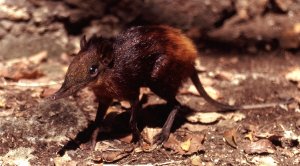 |
The Golden-rumped Sengi (Rhynchocyon chrysopygus) is endemic to Kenya. The most important site for this species is Arabuko-Sokoke Forest, providing 372 km² of habitat and supporting around 10,000 to 20,000 individuals. The species is not restricted to true forest, however outside of this habitat they usually occur at low densities. These secondary habitats probably cover less than 500 km². The species is listed as Endangered based on its small range area (extent of occurrence less than 5,000 km²), and habitat that is severely fragmented and declining due to clearance of scrub and woodlands, and agricultural encroachment. Photo © Galen Rathbun. |
 |
The Common Hippopotamus (Hippopotamus amphibius) was uplisted from Least Concern to Vulnerable for the 2006 Red List. The most recent population estimates suggest that there has been 7 to 20% decline in common hippo populations since 1994. The primary threats to the species are hunting for meat and ivory (found in the canine teeth) and habitat loss. Illegal or unregulated hunting of common hippos is particularly high in areas of civil unrest. A recent field survey found that populations in DRC have declined more than 95% as a result of intense hunting pressure, during more than eight years of civil unrest and fighting. Estimates of the amount of hippo ivory illegally exported have also increased, and its reliance on fresh water habitats, which are themselves threatened from water diversion and development, put the species in direct conflict with human populations. Photo © Jean-Christophe Vié. |
 |
Juliana's Golden Mole (Neamblysomus julianae) is an Endangered species, endemic to South Africa. Only three subpopulations are known and much of the habitat of the topotypical subpopulation (currently listed as Critically Endangered) has been dramatically altered and degraded as a result of urbanization and high-density housing developments along the Bronberg Ridge in Tshwane (Pretoria). Quartzite mining operations threaten to destroy the sole remaining dispersal corridor between eastern and western subpopulations, which could lead to genetic erosion and reduced population viability. Photo © Tim Jackson. |
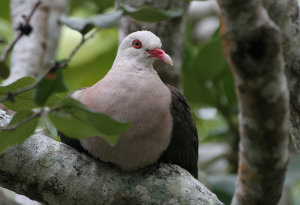 |
The Pink Pigeon (Nesoenas mayeri) survives in the Black River Gorges of south-west Mauritius and on Ile aux Aigrettes, just off the eastern coast. Although once common, it declined to just 10 wild individuals in 1990. Since then, intensive management has resulted in a spectacular increase. In January 2000, the wild population was 364 to 375, at four mainland sites plus Ile aux Aigrettes. By the end of 2004, the population was 359 to 395 indviduals, likely nearer the lower estimate. Severe loss of habitat has been compounded by predation of nests and adults by introduced Crab-eating Macaque Macaca fascicularis, mongoose Herpestes auropunctatus, rats and feral cats. Cyclones destroy nests and accelerate habitat degradation. Disease and late-winter food shortages are also threats. The species is currently listed as Endangered. Photo © Kirsty Swinnerton. |
 |
The White-tailed Eagle (Haliaeetus albicilla) was downlisted to Least Concern in 2006. Following a large recovery in many European countries during 1970 to 1990, the species continued to increase virtually everywhere during 1990 to 2000, including key populations in Norway and European Russia (which together hold >55% of the European population). A few small populations in extreme southeast Europe continued to decline, but these losses were outweighed by large increases farther north and west. The European population is now estimated at 5,000 to 6,600 pairs, encompassing 50 to 74% of the global population. Photo © Chris Gomersall (rspb-images.com). |
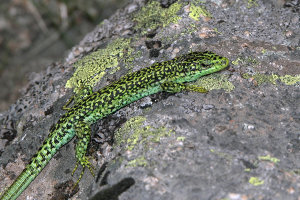 |
Iberolacerta cyreni is endemic to the central mountain system of Spain, where it is a reasonably common species in several areas. However, its populations are highly fragmented and are threatened by habitat loss, especially due to the construction of ski resorts and roads. It might also be adversely affected in future by climate change. Currently listed as Endangered. Photo © Lars Bergendorf. |
 |
The Giant Bronze Gecko (Ailuronyx trachygaster) is endemic to the Seychelles islands of Silhouette and Praslin. In 2005, the total population was estimated at 3,184 to 3,594 animals. Currently listed as Vulnerable because the species has a very restricted range and it will be vulnerable to any degradation of its habitat, for example through the spread of invasive species. Photo © Justin Gerlach. |
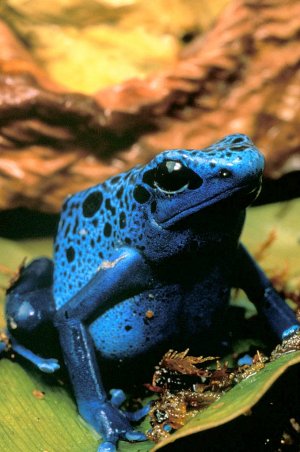 |
The Blue Poison Frog (Dendrobates azureus) is listed as Vulnerable because of its highly restricted range. This frog is known only from the type locality on Vier Gebroeders Mountain, Suriname. It is not significantly threatened in its tiny range, but fire probably has an impact on its forest habitat. Illegal collection of the species for the international pet trade probably no longer has a significant impact, since the species is extensively bred in captivity. Photo © Russ Mittermeier. |
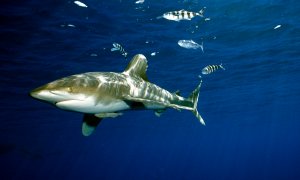 |
The Oceanic Whitetip Shark (Carcharhinus longimanus) is one of the most widespread of shark species, ranging across entire oceans in tropical and subtropical waters. The Vulnerable species is subject to fishing pressure virtually throughout its range. It is caught in large numbers as a bycatch in pelagic fisheries, with pelagic longlines, probably pelagic gillnets, handlines and occasionally pelagic and even bottom trawls. Its large fins are highly prized in international trade although the carcass is often discarded. Fishery pressure is likely to persist if not increase in future. Efforts are underway to improve the collection of data from some regions and effective conservation and management of this species will require international agreements. Photo © Jeremy Stafford-Deitsch. |
 |
The Angel Shark (Squatina squatina) was uplisted from Vulnerable to Critically Endangered in 2006. This large angel shark formerly was a common and important demersal predator in coastal and outer continental shelf sediment habitat in the Northeast Atlantic, Mediterranean and Black Seas. Most of this region is now subject to intense demersal fisheries, and the species is highly vulnerable to bycatch in benthic trawls, set nets and bottom longlines that now operate through most of its range. Its abundance has declined dramatically during the past 50 years. It has been declared extinct in the North Sea and has apparently been extirpated from large areas of the northern Mediterranean. It is now extremely uncommon throughout most its remaining range. Photo © Simon Rogerson. |
 |
The Manta Ray (Manta birostris) is has a wide range in tropical and semi-tropical shelf waters. Only a few directed fisheries exist. Recent demand for branchial filaments, which are dried and exported for the Asian medicinal market, has resulted in dramatic increases in fishing pressure for mobulids, including mantas, throughout South East Asia and Eastern Africa. Population declines have been observed in the Philippines, Mexico, Sri Lanka/India, Indonesia. Anthropogenic pressures (i.e., direct/indirect fisheries, pollution, and exploitation of coastal environments) in areas supporting critical habitats like breeding, birthing, and nursery grounds threaten the species. Currently listed as Near Threatened. Photo © Tim Clarke. |
 |
Telestes polylepis is a Critically Endangered freshwater fish, known only from a very small stream (1 m wide and 2 km long) in Stanicka Jaruga, Croatia. Ongoing habitat degradation caused by water extraction and the presence of introduced trout species threatens the survival of this fish. Photo © Jörg Freyhof. |
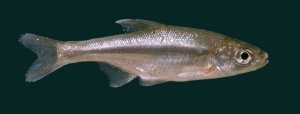 |
Fifty years ago, Acanthobrama telavivensis was very abundant in the coastal rivers of Israel. There was a sharp decline between 1950 and 1970. Then the population was stable until 1999. In 1999, drought resulted in the riverine habitat disappearing and the population declined almost to extinction. The last remaining individuals were taken from the remnants of its habitat and bred in captivity in an attempt to save the species. Two subpopulations now have been reintroduced back into the wild from this captive stock. One subpopulation has not reproduced and the status of the other subpopulation is not known. Until it can be confirmed that the species is breeding successfully in the wild, the species is listed as Extinct in the Wild. Photo © Menachem Goren. |
 |
The Golden Dancing Jewel (Platycypha auripes) occurs in forest streams of the Eastern Arc Mountains, Tanzania. It is restricted to the East Usambara, Uluguru and Udzungwa mountains, and the forest areas of all three mountain ranges have been largely destroyed during the last century. Often only forests on hilltops remain, where no suitable breeding habitats exist. Currently only parts of the East Usambara and the Udzungwa mountains have some kind of protection. The species is currently listed as Vulnerable. Photo © Viola Clausnitzer. |
 |
The Shining Macromia Dragonfly (Macromia splendens) is endemic to southwest France and the Iberian Peninsula. This emblematic species is difficult to find. However, new data show that it is less rare than previously believed. Although flourishing populations occur, partly due to the construction of hydroelectric dams, which seem to support good populations when they are elongated and look like large rivers, a general degradation of water quality is noted almost anywhere and the population appears to be in decline. This species disappears rapidly when faced with water pollution. This and the dramatic droughts, which repeatedly affect Iberia, will inevitably lead to the reduction of many populations in this area in the next decade. The species is currently listed as Vulnerable. Photo © Adolfo Cordero Rivera. |
 |
The Pallid Squill (Scilla morrisii) is found only in three locations on Cyprus. Less than 600 individuals are known to exist and the survival of the species depends on conservation of the remaining oak forests. Logging for timber, road construction and expansion of farmland has considerably reduced these forests and large old oak trees have become rare and scattered where there used to be a closed forest cover. While the S. morrisii population currently does not seem to be declining, the extent of its habitat is decreasing due to road construction and increased agricultural land use. The species entered the 2006 Red List as Critically Endangered. Photo © C.S. Christodoulou. |
 |
Faviero de Wilson (Dimorphandra wilsonii) is a Critically Endangered tree, found only in Minas Gerais State in southeast Brazil. There are only 10 mature trees and six juveniles growing in the wild, in the middle of pastures of Brachiaria (an alien invasive grass species), in a very deforested and fragmented region. The species is threatened by deforestation for charcoal production; this is the most important threat to the Cerrado Biome. There is also deforestation for pasture establishment and any seedlings face competition from Brachiaria. People also deliberately eradicate this species because its seeds can be harmful to pregnant cattle. Photo © Fernando M. Fernandes. |
 | Femeniasia balearica is a Critically Endangered woody perennial shrub, endemic to the Balearic Islands, Spain. It now occurs only in six sites in the north of the island of Minorca, with fewer than 2,200 individuals remaining. Building and road construction threaten the species, although these activities may also create opportunities for colonization. This plant is often removed from beach paths because of its spines. It has also been observed that in some years the activities of wood-eating beetles (Oxythrea funesta and Tropinota hirta) seem to reduce seed germination. Photo © HerbaiVirtual de les Illes Barears. |
 |
Funcia di Basiliscu (Pleurotus nebrodensis) entered the 2006 Red List as Critically Endangered. This mushroom only occurs in northern Sicily, growing in scattered localities in the Madonie Mountains. It is estimated that less than 250 individuals reach maturity each year. The species has been a sought-after since ancient times, and today remains a prized species. Given its rarity, it is sold in northern Sicily at a price fluctuating between 50 to 70 Euros per kg. However, as it is so rare there is no formal market and the mushroom is used in only a few restaurants. Population declines are due to the increasing number of mushroom gatherers, encouraged by the high price this mushroom commands. Photo © Guiseppe Venturella. |